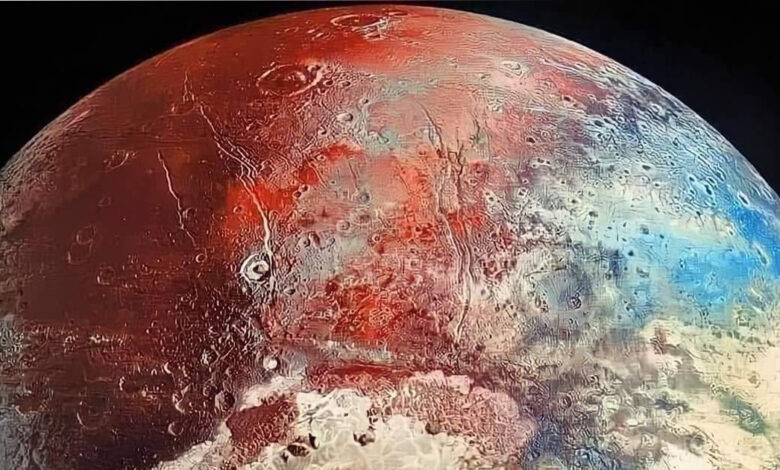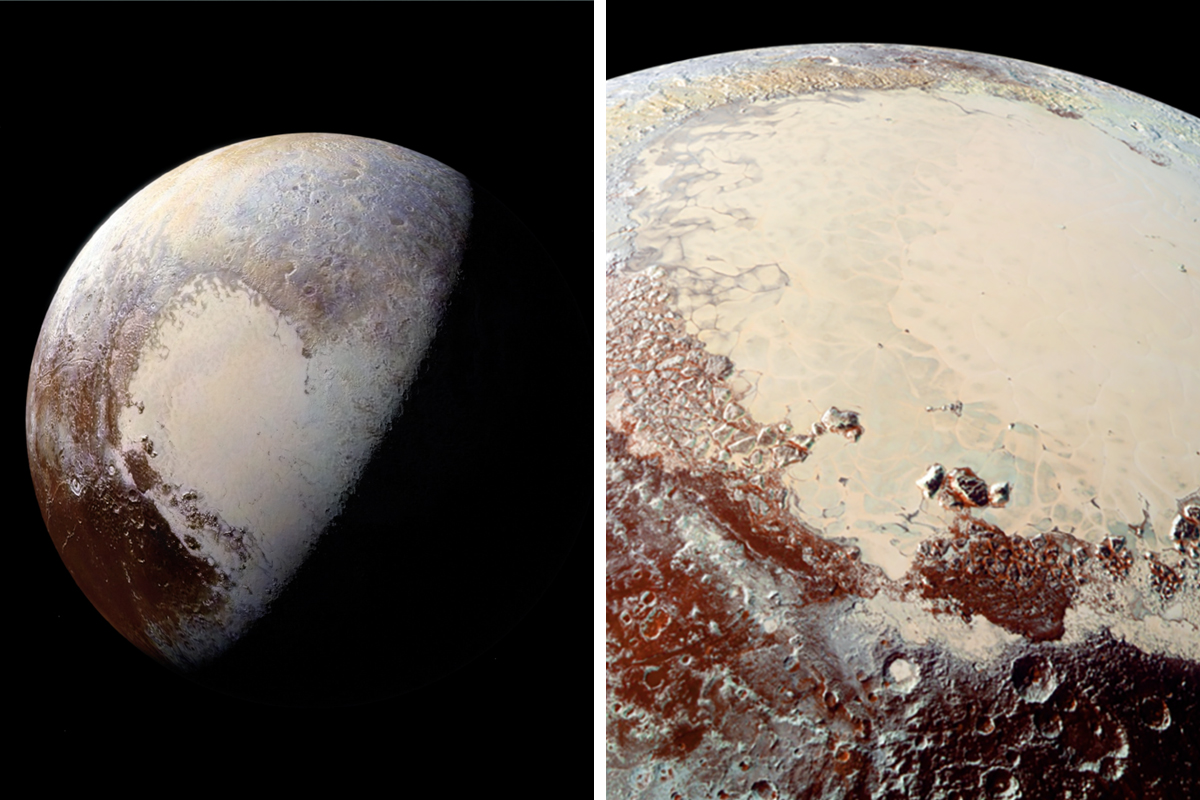New Horizons’ Last Portrait Unveiling Pluto’s Puzzling Spots

In a groundbreaking moment for space exploration, NASA’s New Horizons spacecraft has captured its most detailed image yet of Pluto’s mysterious dark spots. Taken from a distance of just two and a half million miles from the dwarf planet, this image provides an unprecedented view of four intriguing dark areas on Pluto’s surface. These spots, which have captivated scientists since their discovery, are located on the side of Pluto that perpetually faces its largest moon, Charon. As New Horizons approaches its closest flyby on July 14, 2015, this image represents the last clear view of Pluto’s far side that humanity will have for decades to come.
The Significance of New Horizons’ Latest Image

The latest image from New Horizons marks a pivotal moment in our understanding of Pluto. Captured from a distance of just 2.5 million miles, it provides the clearest view yet of the dwarf planet’s mysterious surface features. This unprecedented clarity allows scientists to examine Pluto’s geology in detail, potentially unlocking secrets about its formation and evolution.
The Technical Achievement Behind the Image

New Horizons’ ability to capture such a detailed image from billions of miles away is a testament to the spacecraft’s advanced imaging technology. The Long Range Reconnaissance Imager (LORRI) aboard New Horizons is a state-of-the-art telescope with a 20.8-centimeter aperture, capable of capturing high-resolution images even in the dim light at the edge of our solar system.
The process of transmitting these images back to Earth is equally impressive. Due to the vast distance between New Horizons and Earth, radio signals from the spacecraft take hours to reach us. Despite this challenge, NASA’s Deep Space Network of radio telescopes successfully receives and assembles these data transmissions, allowing scientists to piece together these groundbreaking images of Pluto.
The Scientific Implications of the New Data

This latest image has significant implications for our understanding of Pluto. The clear view of the dark spots and their surrounding terrain provides valuable data about Pluto’s surface composition and geology. Scientists can now study the distribution and characteristics of these features in unprecedented detail, potentially revealing clues about Pluto’s internal structure and past geological activity.
Moreover, the image’s clarity allows researchers to identify smaller surface features that were previously invisible. This could lead to the discovery of impact craters, which would provide insight into the history of collisions in the Kuiper Belt, the region of the solar system where Pluto resides.
Public Engagement and the Power of Space Imagery

Beyond its scientific value, this image of Pluto has captured the public imagination. As the clearest picture yet of this distant world, it has reignited interest in space exploration and the mysteries of our solar system. The image has been widely shared on social media and news outlets, demonstrating the power of space imagery to inspire and educate the public about scientific discoveries.
Unraveling the Mystery of Pluto’s Dark Spots
/https://tf-cmsv2-smithsonianmag-media.s3.amazonaws.com/filer/be/d4/bed4dfa3-55db-45ca-a7cd-18bf96028180/15n_fm2015_plutocrescentviajhuapl_live-cr.jpg)
The dark spots on Pluto’s surface have been a source of intrigue for scientists since their initial discovery. These features, now estimated to be about 300 miles (480 kilometers) across, have puzzled researchers with their similar size and even spacing. The latest image from New Horizons provides new details that may help solve this cosmic mystery.
Characteristics of the Dark Spots

The new image reveals that the dark spots are more complex than initially thought. They appear to be connected to a dark belt that circles Pluto’s equatorial region, suggesting they might be part of a larger geological feature. The spots’ boundaries are irregular but sharply defined, contrasting starkly with the brighter terrain surrounding them.
Their size is particularly noteworthy – each spot covers an area roughly equivalent to the state of Missouri. This consistency in size across multiple spots is unusual and has led scientists to speculate about their origin and formation process.
Theories About Their Formation

Scientists have proposed several theories to explain the formation of these dark spots. One hypothesis suggests they could be the result of material welling up from beneath Pluto’s surface, possibly due to cryovolcanic activity. Another theory posits that they might be impact basins, formed by collisions with other objects in the Kuiper Belt.
The regular spacing of the spots has led some researchers to speculate about potential subsurface processes that could create such evenly distributed features. However, without more data, these theories remain speculative.
Implications for Pluto’s Geology
The presence of these dark spots has significant implications for our understanding of Pluto’s geology. Their existence suggests that Pluto has a more complex and dynamic surface than previously thought. If the spots are indeed the result of internal processes, it would indicate that Pluto has been geologically active much more recently than expected for such a small, cold world.
Furthermore, the sharp boundaries between the dark and light areas suggest that Pluto’s surface may be composed of different materials with distinct properties. This heterogeneity could provide clues about Pluto’s composition and the processes that have shaped its surface over time.
The New Horizons Mission: A Journey to the Edge of the Solar System

The New Horizons mission represents a pinnacle of human exploration, venturing to the very edge of our solar system to study Pluto and its moons. Launched in 2006, this intrepid spacecraft has traveled over three billion miles to reach its target, carrying with it the hopes and curiosity of scientists and space enthusiasts around the world.
The Mission’s Objectives
New Horizons’ primary objective is to conduct the first close-up study of Pluto and its system of moons. This includes mapping the surface composition and temperature of Pluto and its largest moon, Charon, as well as searching for additional satellites and analyzing Pluto’s atmosphere.
Beyond these specific goals, the mission aims to expand our understanding of the Kuiper Belt, the region of the solar system beyond Neptune’s orbit where Pluto resides. By studying Pluto and potentially other Kuiper Belt Objects, New Horizons could provide insights into the early formation of our solar system.
The Spacecraft’s Instruments
To achieve its ambitious goals, New Horizons is equipped with a suite of seven advanced scientific instruments. These include:
- The Long Range Reconnaissance Imager (LORRI): A telescopic camera that provides high-resolution images.
- Ralph: A visible and infrared imager/spectrometer that maps surface composition.
- Alice: An ultraviolet imaging spectrometer that analyzes atmospheres and searches for atmospheres around Charon.
- REX (Radio Science Experiment): Measures atmospheric composition and temperature.
- SWAP (Solar Wind Around Pluto): Studies solar wind interactions and the escape rate of Pluto’s atmosphere.
- PEPSSI (Pluto Energetic Particle Spectrometer Science Investigation): Measures the composition and density of plasma escaping from Pluto’s atmosphere.
- SDC (Student Dust Counter): Measures the space dust impacting New Horizons during its voyage.
The Challenges of Deep Space Exploration
The New Horizons mission has faced numerous challenges in its journey to Pluto. Operating a spacecraft at such vast distances from Earth presents unique difficulties. The extreme cold of outer space, the need for precise navigation, and the long communication delays all pose significant obstacles.
Perhaps the most daunting challenge is power management. New Horizons uses a radioisotope thermoelectric generator (RTG) for power, as solar panels would be ineffective so far from the Sun. This power source, while reliable, provides a limited amount of energy, requiring careful management of the spacecraft’s systems and instruments.
The Significance of Pluto in Our Understanding of the Solar System

Pluto, once considered the ninth planet of our solar system, holds a unique place in both scientific study and public imagination. Its reclassification as a dwarf planet in 2006 sparked debates that continue to this day, highlighting the evolving nature of our understanding of the solar system.
Pluto’s Unusual Characteristics
Pluto exhibits several characteristics that set it apart from the other planets in our solar system. Its highly elliptical orbit, which occasionally brings it closer to the Sun than Neptune, and its orbital tilt of 17 degrees are unlike anything seen in the eight recognized planets. These peculiarities have led scientists to speculate about Pluto’s origin and its relationship to the other bodies in the Kuiper Belt.
Pluto’s composition is also of great interest. It’s believed to consist of a rocky core surrounded by a mantle of water ice, with a surface covered in a layer of frozen nitrogen, methane, and carbon monoxide. This mixture of ices gives Pluto a complex geology that scientists are eager to study in more detail.
The Kuiper Belt and Early Solar System Formation
As a member of the Kuiper Belt, Pluto serves as a window into the early days of our solar system. The Kuiper Belt is thought to be a reservoir of primordial material left over from the formation of the planets. By studying Pluto and other Kuiper Belt Objects, scientists hope to gain insights into the conditions and processes that shaped our solar system billions of years ago.
Pluto’s Moons and the Possibility of Subsurface Oceans
Pluto’s system of moons, particularly its largest moon Charon, adds another layer of intrigue to this distant world. The Pluto-Charon system is unique in our solar system, with Charon being so large in proportion to Pluto that the two bodies orbit a point in space between them, like a double planet system.
Recent studies have suggested the possibility of subsurface oceans on both Pluto and Charon. If confirmed, this could have significant implications for the potential for life in the outer solar system, expanding our understanding of where liquid water – and potentially life – might exist.
The Future of Pluto Exploration

As New Horizons completes its historic flyby of Pluto, the future of Pluto exploration looks both exciting and challenging. The data gathered by this mission will undoubtedly spark new questions and avenues of research, potentially paving the way for future missions to this distant world.
Analyzing New Horizons’ Data
The wealth of data collected by New Horizons during its flyby will take years to fully analyze. Scientists will pore over the images, spectral data, and other measurements to build a comprehensive picture of Pluto’s geology, atmosphere, and place in the solar system. This analysis is likely to lead to numerous scientific papers and potentially groundbreaking discoveries about the nature of Pluto and the Kuiper Belt.
Potential Future Missions
While there are currently no concrete plans for another mission to Pluto, the success of New Horizons and the intriguing data it has returned may well inspire future exploration efforts. Potential mission concepts could include an orbiter to study Pluto over an extended period, or even a lander to directly sample Pluto’s surface.
However, any future mission to Pluto would face significant challenges. The vast distance to Pluto means long travel times and difficulties in power generation and communication. Advanced propulsion technologies and innovative mission designs would likely be necessary to make such a mission feasible.
The Role of Pluto in Comparative Planetology
As our understanding of Pluto grows, it will play an increasingly important role in the field of comparative planetology. By comparing Pluto’s characteristics with those of other planets and moons in our solar system, scientists can gain insights into the diverse ways planets can form and evolve.
This comparative approach could be particularly valuable as we discover more exoplanets around other stars. The lessons learned from studying Pluto could help us understand the potential diversity of worlds that might exist in other solar systems.
Conclusion

The latest image from New Horizons marks a historic moment in our exploration of the solar system. It provides us with our clearest view yet of Pluto’s enigmatic surface features, offering tantalizing clues about the geology and history of this distant world. As New Horizons continues its approach, we stand on the brink of a new era in our understanding of Pluto and the outer solar system.
The mysterious dark spots, with their regular spacing and complex structure, highlight how much we still have to learn about Pluto. They serve as a reminder of the surprises that await us as we push the boundaries of space exploration. The New Horizons mission, with its suite of advanced instruments, is poised to revolutionize our knowledge of Pluto, potentially reshaping our understanding of planetary formation and evolution.
As we eagerly await the data from New Horizons’ closest approach, we can reflect on the incredible journey that has brought us to this point. From Pluto’s discovery in 1930 to this moment of unprecedented close-up observation, our quest to understand this distant world embodies the spirit of scientific inquiry and human curiosity.
The exploration of Pluto and the Kuiper Belt represents more than just a scientific endeavor. It’s a testament to human ingenuity and our relentless drive to explore the unknown. As we unravel the mysteries of Pluto, we not only expand our knowledge of the solar system but also inspire future generations to push the boundaries of exploration even further.
In the coming days and years, as New Horizons continues to transmit its treasure trove of data back to Earth, we can look forward to many more discoveries and insights about Pluto and its place in our cosmic neighborhood. This mission marks not an end, but a beginning – opening up new questions, new possibilities, and new horizons in our ongoing journey to understand the universe around us.

